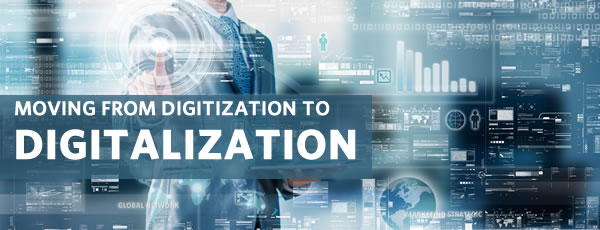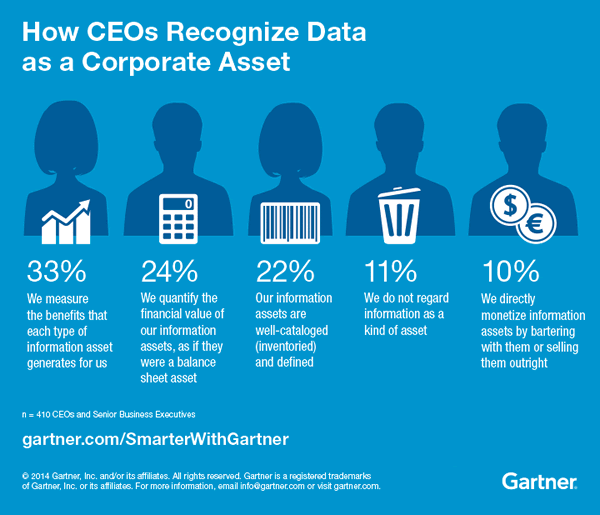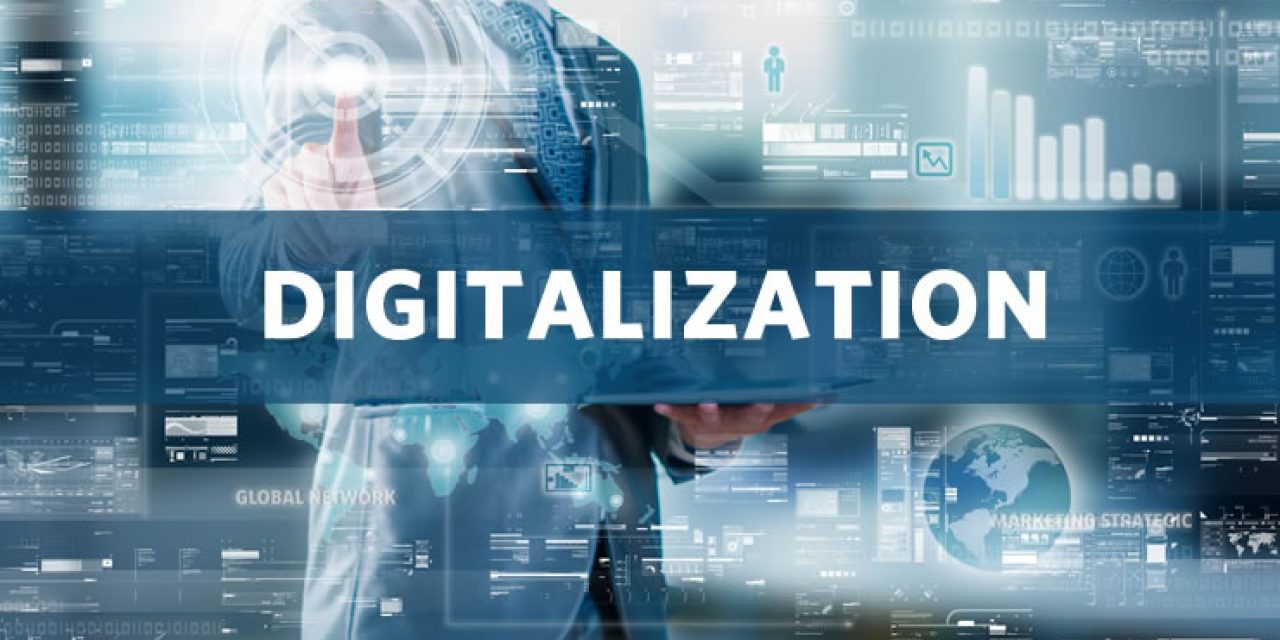A large majority of organizations are still implementing ad hoc digital strategies and/or limiting themselves to automation and the digitization of paper-based processes. That’s necessary but digitization is not enough.
You can’t move towards digitalization if you haven’t digitized enough yet. True, by digitizing paper-based information and business processes, there are ample benefits to realize: you can lower the risks of errors, speed up processes (paper-based processes are slow and prone to errors), enhance customer satisfaction, lower operating costs and to some extent change and improve specific parts of the business. Many large-scale digitization operations are really about business process engineering to begin with.
Digitalization is the process of moving to become a digital business, realize a digital workplace, creating a digital supply chain, etc.
Yet, in order to move to digitalization and digital transformation in an enterprise-wide sense and reach the next levels of digital maturity amidst rapidly changing market and economy conditions, customer attitudes/expectations, disruptive forces and new technologies that are about to contribute to even faster disruption, it’s important to start digitalizing.

What is digitalization anyway?
One of the goals of digitization exercises in fact should be to enable digitalization.
The costs which are saved through digitization are good for the short and medium term, yet should help funding the longer term as well. And, in order to move towards that longer term where a digital transformation economy will be at the core of digital business, digitalization is the road to take.
What do we mean with digitalization? There is no universal digitalization definition but it’s not the same as digitization which is often an enabler, always a ‘condition sine qua non’ and in a way a part of digitalization. Some examples will make it clearer.
On the road towards digital transformation and innovation, digitizing data and processes isn’t enough
Digitalization is the path towards digital business and an essential part of moving towards digital transformation. So what is digitalization not? It is not digitization and it is not digital transformation. Both digitization and digitalization on one hand and digitalization and digital transformation on the other are often used interchangeably. A quick look at the differences with some examples.
Digitization
Digitization is simply the automation and/or digitization of business processes which in turn is based on the digitization of paper (so, removing paper-based processes), and along with this the removal of manual labor where it isn’t viable or effective/efficient.
It’s really the first step. Digital transformation on the other hand, is a very vast and enterprise-wide exercise that fundamentally transforms a business with a focus on processes, capabilities, acceleration, innovation, the creation of new revenue streams and even a full change of business model.
Digital transformation
There are ample examples in the industry where the core business is shifting in a context of digitalization and digital transformation, which is an ongoing journey with DX at the core.
As an example, let’s take John Deere. With its focus on embedded technologies (IoT) and on data, John Deere is moving from being a manufacturer of equipment to a services and data company. It is becoming an advisor to farmers, for instance, with entirely new business models and revenue streams that in later digital transformation stages can be combined with novel business models of other companies, sometimes from entirely different sectors, in order to become a disruptive company or part of a disruptive ecosystem that changes the way farming is done.
While this might not be the case for John Deere, which might continue operating in its current core business as well, some organizations who are going through such profound transformations can even drop their entire existing core business. Several companies which went bankrupt in this age of accelerating digital innovation had the possibility to grow new revenue streams but kept stuck too much on their core business with the known consequences.
So, as you can see, digital transformation, in the modern sense (not in the old sense of turning paper into digital data) goes far beyond digitization and encompasses the full businesses across all activities and across existing and new ecosystems.
Defining digitalization
In that sense, digitalization is more related with digital transformation as it is with digitization.
Whereas digitization is at the beginning, digitalization means the use of digital technologies and of data (digitized and natively digital) in order to create revenue, improve business (not just processes) and create a digital culture whereby digital information is at the core.

The information technology dimension of digitalization
As you could see in the graphic by Gartner above, digitalization has an important information and information technology dimension whereby we see, among others, analytics, systems of insight and technologies that enable to put digitized information at work beyond a pure digitized process perspective and more in a value generation perspective.
The digital maturity/culture dimension of digitalization
Digitalization also has a dimension of ‘digital maturity’ or ‘digital culture’, whereby data and information, put at work with the needed technologies, serve as business assets and enablers to come up with digital services, increase the usage of digital platforms and transform the ways business is conducted, for instance in the context of the digital workplace, digital supply chain, digital customer experience and anything digital really (except the pure data and process aspect, which, again, is digitization).
Digitalization and processes
Whereas the process dimension of digitization is about the automation of processes and moving from analog to digital information as explained, in digitalization we are not talking about digitizing and thus optimizing existing processes but reengineering, replacing and increasing business processes for digital business.
Digitalization as the path to digital business and digital transformation
Last but not least, digitalization is the next stage after digitization on the way to not just digital business but also towards creating the capabilities and conditions, among others in the ways the business operates and how it leverages knowledge and insights, which are needed for enterprise-wide digital transformation and the nascent digital transformation economy where digital transformation moves to the core of the business (remember the John Deere example).
How digitization can lead to digitalization
Obviously these steps are not nicely consecutive so we can’t put them in a roadmap-like overview for all organizations.
In practice organizations can be at the same time digitizing and digitalizing in some areas as they move at various speeds. Still, you need to have a strategic roadmap as we’ll see. But with digitalization the systems are connected and everything gets brought together in order to move to the next stage.
To capture the breadth, depth, and transformative potential of this digital revolution, embrace digitalization (Denise Garth) Source
Sometimes digitization can lead to digitalization. We have seen examples in government, for instance, where large digitization projects in the context of business process reengineering have led to a skillset which enabled one government department to develop new ‘business streams’ by offering the acquired skills and technologies to other departments as a service.
We have also seen examples of insurance companies who went beyond digitizing their processes and information flows and leveraged the results of their digitization, integration (back end and front office, beyond silos) and innovation exercises to come up with new pricing models (for instance by using telematics as is increasingly done) and even come up with entirely new products. Taking into account regulations, which are of course strict in this industry, in next stages insights, gained out of information, can then become new revenue streams as such.
An example in that sense is a telecom provider which sells location data to governments, companies and event organizers who want insights into where people came from, are and go to.
It’s sheer market intelligence that can be used by these ‘buyers’. In the case we know they don’t sell location data of uniquely identifiable customers but of groups of customers, enabling the firms that buy this intelligence to adapt and improve the ways they do business or organize events, processes, etc. You can imagine how in the example of insurance firms, comparable initiatives which build upon aggregated data, could serve other companies. That’s where we are heading to and that’s, among others, what digitalization in practice is about. It’s far away from simply digitizing and it’s a step closer to digital business transformation as we’ll increasingly understand it.
Moving from digitization to digitalization in practice
So, digitize but don’t stop there. Digitalize as you move up the digital transformation maturity ladder.
How do you get there? Below are some tips to move from a pure digitization situation and/or project towards the conditions which are needed for digitalization and digital transformation (and in this stage it’s OK to use both more or less interchangeably).
Looking beyond the immediate digitization business case
When making your business case for digitization projects don’t just look at the immediate needs and goals but also look at how you can leverage data to service customers better, build new offerings and come up with new revenue streams.
Choosing the right partners
Don’t see a digitization and/or document capture project as just a way to save costs and/or be more productive, efficient and so forth. Talk with a partner who does more than just digitization but also can think with you on how to leverage the fruits of these projects.
Involve others
Don’t approach the digitization project from the perspective of the traditional small group of people who would usually take care of it. Build bridges with other departments and colleagues. Let the digitization project work in function of the goals and potential you see as a team instead of just the immediate deliverables.
Invest to invest
Invest in a digitization project but also in other projects, such as the insurance examples we mentioned with telematics, and in new products with the next investments to move towards digitalization and digital transformation in mind. In other words: reserve part of the cost savings, economies of scale and potential revenues for the next steps.
Work with end goals in mind
Have those next steps in mind. The reason to work with forward-thinking partners and other departments, whereby you can look at examples of successful digitalization and transformation initiatives (also from outside your industry), see where customer demand is heading, where your sector is going, what technologies are coming and what their impact can be, where disruption could come from, what the needs and insights of others are and so on, in the end is to define a vision and roadmap whereby each step helps fund the next one, as just mentioned.
Build and buy to scale, move fast and integrate
When considering a digitization solution that involves capture software and other applications, don’t get stuck with a system that only does what you need today. What are the evolving needs of your (mobile) workforce? What other systems and LOB applications do you need to connect with now and in later stages? Is there a better option available to scale fast and move equally fast when the next steps in your digitalization and transformation roadmap are coming?
In practice this will among others mean looking at web-based solutions, at cloud computing, at systems of insight and systems of engagement (not just the traditional systems of records that are still present in the capture and digitization market) and probably at mobile and open data architectures with a focus on connectivity and data exchange.
Top image: Shutterstock – Copyright: Vasin Lee – All other images are the property of their respective mentioned owners.






